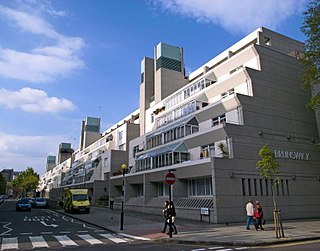
The Brunswick Centre is a grade II listed residential and shopping centre in Bloomsbury, London, England. It is located between Brunswick Square and Russell Square and is administratively in the London Borough of Camden.
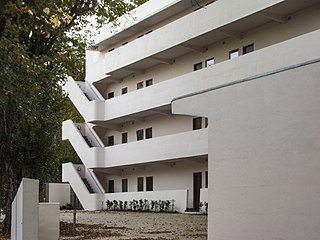
Isokon Flats, also known as Lawn Road Flats and the Isokon building, on Lawn Road in the Belsize Park district of the London Borough of Camden, is a reinforced-concrete block of 36 flats, designed by Canadian engineer Wells Coates for Molly and Jack Pritchard.
Sir Nicholas Grimshaw is a prominent English architect, particularly noted for several modernist buildings, including London's Waterloo International railway station and the Eden Project in Cornwall. He was President of the Royal Academy from 2004 to 2011. He was chairman of Grimshaw Architects from its foundation to 2019, when he was succeeded by Andrew Whalley. He is a recipient of the RIBA Gold Medal.

Robin Hood Gardens is a residential estate in Poplar, London, designed in the late 1960s by architects Alison and Peter Smithson and completed in 1972. It was built as a council housing estate with homes spread across 'streets in the sky': social housing characterised by broad aerial walkways in long concrete blocks, much like the Park Hill estate in Sheffield; it was informed by, and a reaction against, Le Corbusier's Unité d'Habitation. The estate was built by the Greater London Council, but subsequently the London Borough of Tower Hamlets became the landlord.
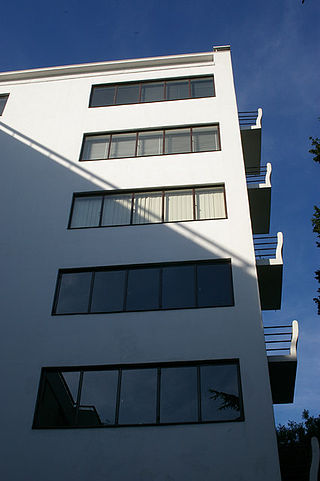
Highpoint I was the first of two apartment blocks erected in the 1930s on one of the highest points in London, England, in Highgate. The architectural design was by the Georgian-British architect Berthold Lubetkin, the structural design by the Anglo-Danish engineer Ove Arup and the construction by Kier.
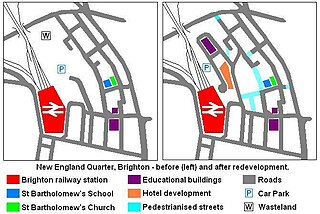
The New England Quarter is a mixed-use development in the city of Brighton and Hove, England. It was built between 2004 and 2008 on the largest brownfield site in the city, adjacent to Brighton railway station. Most parts of the scheme have been finished, but other sections are still being built and one major aspect of the original plan was refused planning permission.
Grimshaw Architects is an architectural firm based in London. Founded in 1980 by Nicholas Grimshaw, the firm was one of the pioneers of high-tech architecture. In particular, they are known for their design of transport projects including Amsterdam Bijlmer ArenA railway station, Waterloo International railway station and the award-winning Southern Cross railway station which was the recipient of the Royal Institute of British Architects Lubetkin Prize. Grimshaw is behind the design of the Sustainability Pavilion, an innovative net-zero building, for Expo 2020. The firm currently has offices in Los Angeles, New York, London, Paris, Dubai, Melbourne and Sydney, employing over 600 staff.
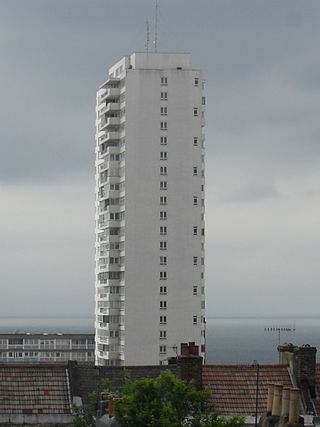
Sussex Heights is a residential tower block in the centre of Brighton, part of the English city of Brighton and Hove. Built between 1966 and 1968 on the site of a historic church, it rises to 102 m (335 ft) and has 116 flats. As of August 2022, the tower is the 125th tallest building in the UK, and until 2005 it was the tallest residential tower in the UK outside of London. Until 2015, it was the tallest structure in Brighton, however it has now been exceeded by the i360 Tower, which stands at 162 metres.

The Van Alen Building is a modern apartment and penthouse block on the seafront in Brighton, part of the English city of Brighton and Hove. It was named after William Van Alen, the architect of New York City's Chrysler Building and is designed as a 21st-century interpretation of the Art Deco and Streamline Moderne styles. It was completed in 2001.

Compass Centre is an office building on the grounds of Heathrow Airport in the London Borough of Hillingdon. The building serves as Heathrow Airport Holdings's head office. Compass Centre previously served as a British Airways flight crew centre.
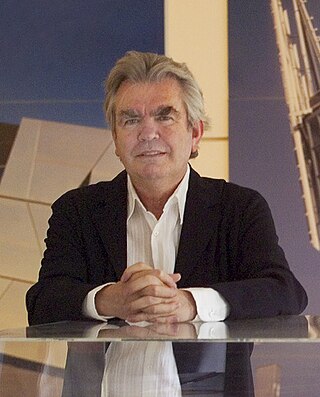
Sir Terence Farrell, known as Terry Farrell, is a British architect and urban designer. In 1980, after working for 15 years in partnership with Sir Nicholas Grimshaw, Farrell founded his own firm, Farrells. He established his reputation with three completed projects in London in the late 1980s: Embankment Place, 125 London Wall aka Alban Gate and SIS Building aka Vauxhall Cross.
The 1950s and 1960s saw the construction of numerous brutalist apartment blocks in Sheffield, England. The Sheffield City Council had been clearing inner-city residential slums since the early 1900s. Prior to the 1950s these slums were replaced with low-rise council housing, mostly constructed in new estates on the edge of the city. By the mid-1950s the establishment of a green belt had led to a shortage of available land on the edges of the city, whilst the government increased subsidies for the construction of high-rise apartment towers on former slum land, so the council began to construct high-rise inner city estates, adopting modernist designs and industrialised construction techniques, culminating in the construction of the award-winning Gleadless Valley and Park Hill estates.
Farrells is an architecture and urban design firm founded by British architect-planner Terry Farrell with offices in London, Manchester, Hong Kong, and Shanghai. The firm has won numerous awards for their characteristic mixed-use schemes, transit-oriented development, contextual urban placemaking, and cultural buildings.

The Southgate Estate was a modernist public housing project located in Runcorn New Town and completed in 1977. The estate was designed by James Stirling, and comprised 1,500 residential units intended to house 6,000 people. The estate was demolished between 1990 and 1992 and replaced with another housing development, known as Hallwood Park, based around more traditional design principles.

Porchester Square is an archetypal-format, narrow London garden square in Bayswater on the cusp of inter-related Westbourne. It is lined with tall white Victorian classical architecture residential buildings.
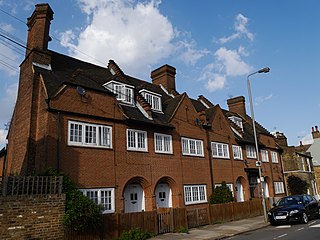
155–171 Oakhill Road is a Grade II listed private block of flats and rear building in an Arts and Crafts style in Putney, in the London Borough of Wandsworth.
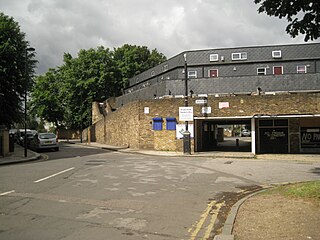
Myatt's Fields South is a social housing estate located between Brixton Road and Camberwell New Road in South London. It is on land that once formed part of the Lambeth Wick estate.

Grenfell Tower is a derelict 24-storey residential tower block in North Kensington in London, England. The tower was completed in 1974 as part of the first phase of the Lancaster West Estate. The tower was named after Grenfell Road, which ran to the south of the building; the road itself was named after Field Marshal Lord Grenfell, a senior British Army officer. Most of the tower was destroyed in a severe fire on 14 June 2017.

Sainsbury's supermarket, Camden is an architecturally notable supermarket building in Camden Road, north London, and is part of the J Sainsbury chain. It was designed by Nicholas Grimshaw & Partners and was completed in 1988, on the site of the former Aerated Bread Company Camden Town bakery. In 2019 it became the first purpose built supermarket to be Grade II listed for its futuristic architecture.
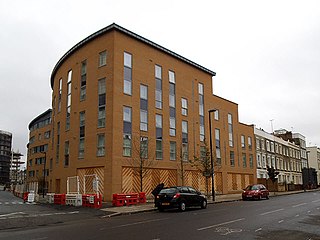
New London Vernacular is the name given to an architectural style of housing developments, observed in London, England, from about 2010. The style has a number of characteristics, notably flat elevations faced in brick cladding, portrait-shaped recessed windows, and the maximisation of homes having front-doors opening onto the street - all features found in London's extensive Georgian and Victorian terraced housing.
















